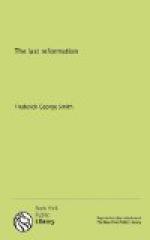Nations may be peaceful or tyrannical and oppressive, and churches may be good or apostate; but the exact character can be analogously represented by the symbolic object. A vicious wild beast stamping and devouring would naturally represent a cruel, tyrannical government; and a good woman represents the true church, while a vile harlot represents the church apostate. But whatever the nature of the symbol, whether beast, locust, lion, horse, temple, angel, or man, we may know at once from the nature of the symbol where to look for its fulfilment. This important guide in the study of prophetic truth—a guide overlooked by most of the commentators—relieves us of much of the uncertainty hitherto connected with the subject.
Since, as we have seen, symbolic language is based on analogy, it is evident that there are some objects whose nature forbids their symbolization, there being no corresponding object in existence. God can not be symbolized. “To whom then will ye liken God? or what likeness will ye compare unto him” (Isa. 40:18). There may be certain symbols connected with his person setting forth the dignity, majesty, and eternal splendor of his name, but he himself appears unrepresented by another. The same is true also of the person of Jesus, our Redeemer, although in this case we must distinguish between the Christ incarnate and Jesus in his essential divinity. Considered as incarnate—both God and man—the human aspect of his character as manifested in his sacrificial death may be analogously represented as a Lamb slain. But considered in his essential divinity, he can not be symbolically represented. Therefore, whenever the glorified Christ appears on the symbolic stage, he always appears in his own person proclaiming his own name. “I am he that liveth, and was dead; and, behold, I am alive for evermore” (Rev. 1:18). “He hath on his vesture and on his thigh a name written, King of kings, and Lord of lords.”
In Rev. 6:9 the souls of the martyrs are represented as crying unto God for the avenging of their blood on them that dwell on the earth. There is no object analogous to a disembodied spirit. It is easy to give them an arbitrary name. Therefore they simply appear under their own appropriate titles as “the souls of them that were slain.”
Whenever we attach a literal significance to a symbolic object, we immediately destroy its character as a symbol. This should not be done. With the exception of those instances where the nature of an object forbids its symbolization and where the description must therefore of necessity be literal, we should always look for the true fulfilment, not in that department from which the symbol is drawn, but in another department—that to which the symbol by analogy refers us.
[Sidenote: Field of present inquiry]




